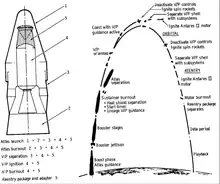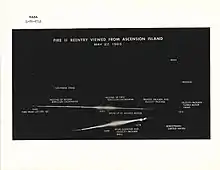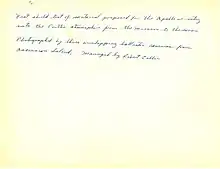


Project FIRE (Flight Investigation Reentry Environment) was a United States National Air and Space Administration NASA effort to determine the effects of Atmospheric entry on spacecraft materials.[1][2]
Project FIRE used both ground testing in wind tunnels and flight tests to test the effects of reentry heating on spacecraft materials, using a subscale model of the Apollo Command Module.[2]
Wind tunnel testing occurred at the 4-foot Unitary Plan Wind Tunnel, the High-Temperature Tunnel, and the Thermal Structures Tunnel at the Langley Research Center located in Hampton, Virginia.
Recoverable reentry packages were flight tested using Atlas-D Antares-2 rockets,[3] launched from LC 12 at Cape Canaveral Air Force Station in Florida, United States.[4][2]

Flights
FIRE 1 - 14.04.1964 - Atlas-D Antares-2
The first Project FIRE reentry package was propelled to an altitude of 122 km by an Atlas D launch vehicle (missile 263D).[5] Following a coasting phase that reached an apogee exceeding 800 km, the velocity package initiated the reentry vehicle's trajectory, plunging it into a trajectory at a velocity of 11,300 meters per second with a minus 15 degree trajectory.[5] As the spacecraft descended towards Earth, a solid-fuel Antares II rocket positioned behind the payload ignited for 30 seconds, elevating the descent speed to 40,501 kilometers per hour.[5] Temperature data from the spacecraft's instruments were transmitted to the ground, indicating an estimated exterior temperature of 11,400 K.[5] Approximately 32 minutes post-launch, the spacecraft made impact into the Atlantic Ocean.[5]
FIRE 2 - 22.05.1965 - Atlas-D Antares-2
During the second trial, a propelled instrumented probe, referred to as a "flying thermometer," was launched into a ballistic trajectory over 805 km high by an Atlas D booster (missile 264D).[5] As the spacecraft initiated its descent after 26 minutes of flight, the Antares rocket accelerated its fall. The probe entered the atmosphere at a velocity of 40,877 km per hour, generating temperatures of approximately 11,206 K.[5] Ground stations received data on heating throughout the descent.[5] Thirty-two minutes post-launch, and a mere six minutes after the Antares ignition, the device impacted in the Atlantic Ocean approximately 8,256 km southeast of the Cape.[5]
References
- ↑ "The Apollo Spacecraft - A Chronology. Vol. II. Part 2 (1964 Jan-Apr)". history.nasa.gov. Retrieved 2023-11-17.
- 1 2 3 "FIRE". www.astronautix.com. Retrieved 2023-11-17.
- ↑ "Atlas-D Antares-2". Gunter's Space Page. Retrieved 2023-11-17.
- ↑ "Image of the Day Gallery". NASA. Retrieved 29 May 2013.
- 1 2 3 4 5 6 7 8 9 "Fire 1, 2".